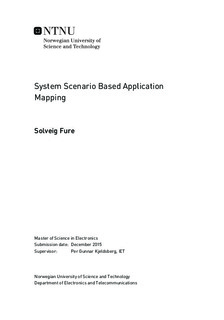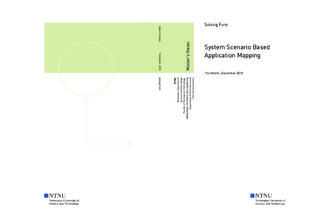| dc.description.abstract | During the past decade, the processing requirements of embedded real-time systems have become more and more challenging; not only in terms of performance, but also regarding the energy efficiency. The dynamic nature of many of these systems has been recognized as an important feature to take advantage of. Scenario-based design is a well-known design methodology dealing with this. Identifying different use-case scenarios to optimize for is a strategy that has been used for a long time. Lately, another kind of scenario-based strategy has emerged; so-called System scenarios. Instead of classifying the behavior of a system through several use-cases, the actual costs of the system is considered, like resource usage or quality requirements. By thoroughly characterizing and analyzing the system behavior at design-time, the different system scenarios can be recognized at run-time without much overhead. The system can then be tailored to the identified scenario by employing the optimal settings that have been determined at design-time. It must however be enough exploitable dynamism present in the application to make up for the system scenario overhead.
The system scenario research field has well described theoretical design methodologies, even considering multiple cost dimensions. It can however be a long distance between the theoretical methodologies and an actual design process, especially when the dynamic cost is multi-dimensional. There is a considerable increase in the design complexity from adding just one more cost dimension to the design, motivating the need for a precise and concrete methodology. This thesis presents methods for detecting and exploiting dynamism in applications through profiling and code inspection, and the results from applying these methods on four applications, where three of them are a subset of the SPEC CPU 2006 integer benchmarks. The focus is on exploring both memory and CPU dynamism. Identifying the dynamism in an application can become very complex when considering multi-dimensional dynamism. An extension to the system scenario methodology which addresses this problem is therefore suggested. The scenario identification step of the original methodology is split into several smaller steps and executed separately for each of the considered dynamisms. This way the designer does not have to keep the entire design space in mind, but can focus on each kind of dynamism separately. Sub-scenarios are identified for each kind of dynamism, and then combined to form a scenario set where the total dynamism is exploited. The methodology is targeted at simple single-core platforms.
Several papers present promising results of the system scenario methodology when only considering CPU optimizations such as Dynamic Voltage and Frequency Scaling (DVFS). For applications requiring much memory however, DVFS can become infeasible as it means longer stand-by time for the memory. Memory typically contributes significantly to the total energy consumption, which motivates the recent introduction of memory system scenarios with dynamically reconfigurable memories. In this work, the dynamism in applications that are both memory and computationally intensive are exploited by combining DVFS and memory reconfigurations. Much CPU and memory dynamism is identified in the considered benchmark applications, and up to 31% of the total energy is saved by applying the modified system scenario methodology. Up to 47% is saved for some of the low-workload situations. Characteristics of an Intel Pentium processor and CACTI memory models are used to estimate the energy savings. | |

